人教版(2019)选择性必修第一册Unit 4 Body Language Opening page & Reading and thinking 课件(共26张PPT,内嵌视频)
文档属性
| 名称 | 人教版(2019)选择性必修第一册Unit 4 Body Language Opening page & Reading and thinking 课件(共26张PPT,内嵌视频) | 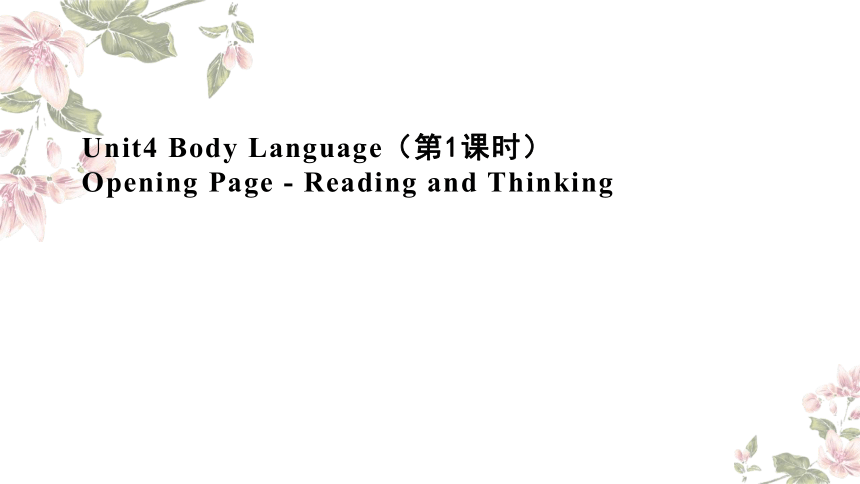 | |
| 格式 | pptx | ||
| 文件大小 | 11.2MB | ||
| 资源类型 | 教案 | ||
| 版本资源 | 人教版(2019) | ||
| 科目 | 英语 | ||
| 更新时间 | 2024-07-15 16:29:58 | ||
图片预览

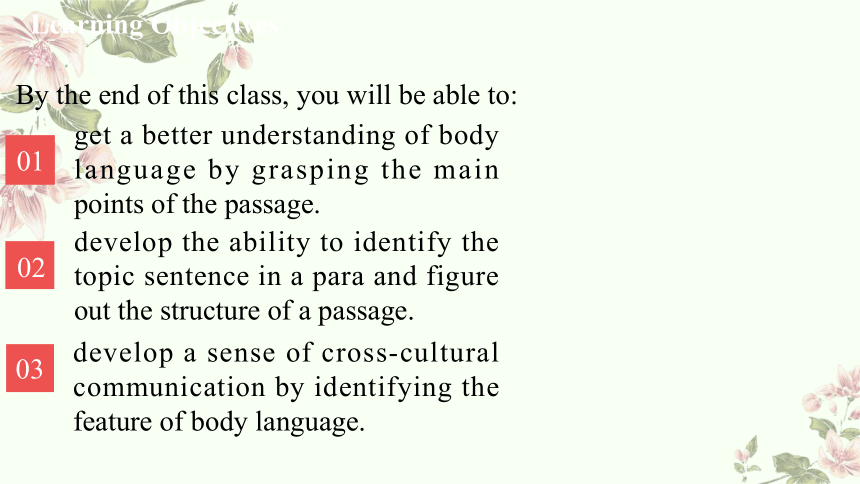


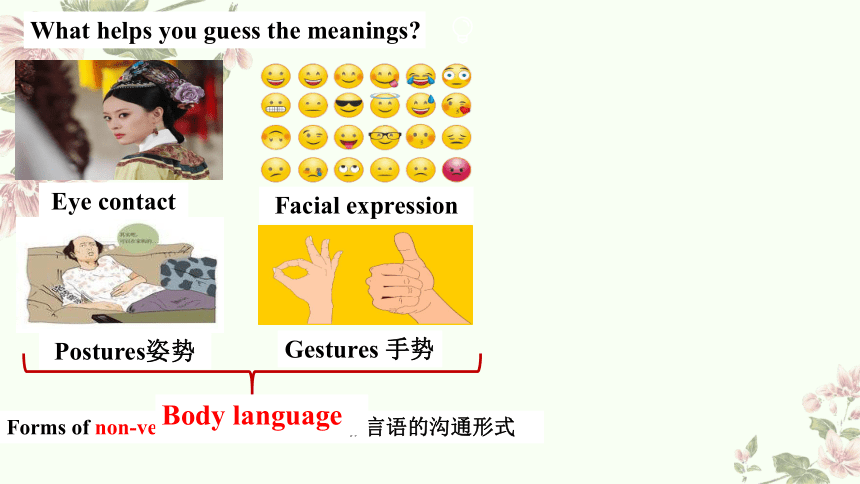
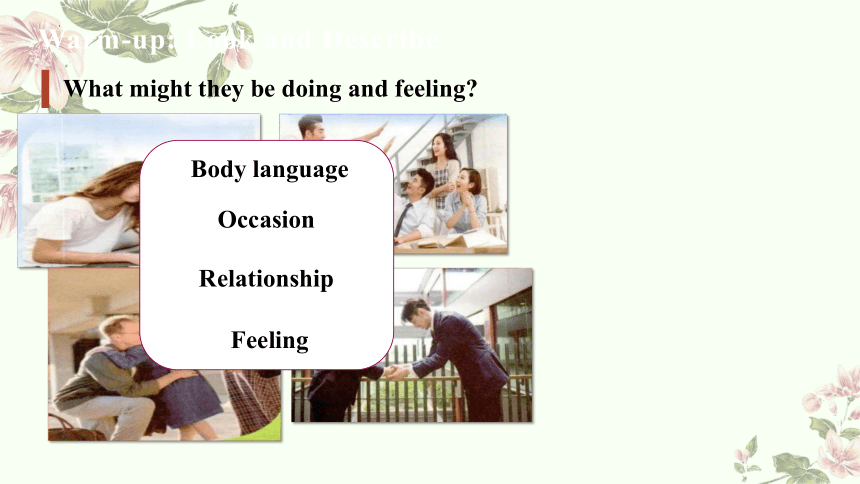
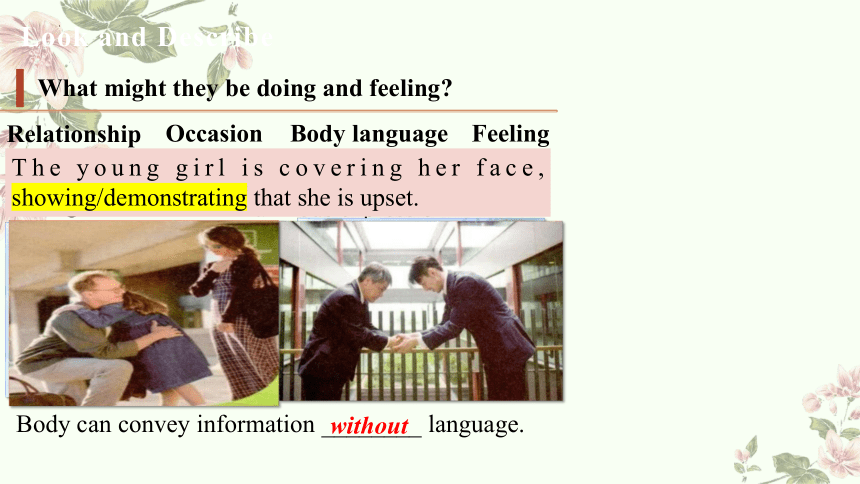

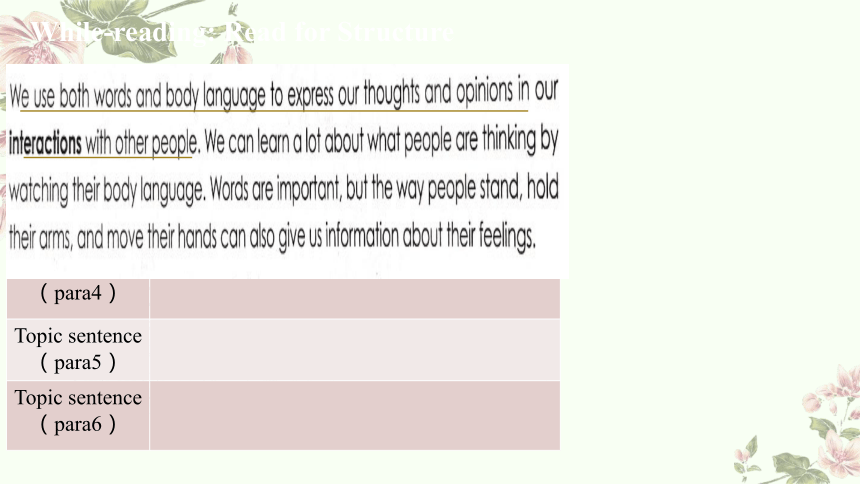
文档简介
(共26张PPT)
Unit4 Body Language(第1课时)
Opening Page - Reading and Thinking
Learning Objectives
By the end of this class, you will be able to:
01
get a better understanding of body language by grasping the main points of the passage.
02
develop the ability to identify the topic sentence in a para and figure out the structure of a passage.
03
develop a sense of cross-cultural communication by identifying the feature of body language.
He is _________.
He is ____.
Look and guess
sad
surprised
He is ______.
This means ______.
tired
great
Look and guess
Her eyes are full of _________.
love/affection
sad
anger/hate/
resentment
sadness/grief frustration
What helps you guess the meanings
Eye contact
Facial expression
Postures姿势
Gestures 手势
Forms of non-verbal communication非言语的沟通形式
Body language
Warm-up: Look and Describe
What might they be doing and feeling
Relationship
Occasion
Body language
Feeling
Look and Describe
What might they be doing and feeling
Body can convey information ________ language.
without
Relationship
Occasion
Body language
Feeling
mother and daughter
talking
cover her face
anxious expression
upset
The young girl is covering her face, showing/demonstrating that she is upset.
Pre-reading: Look and Predict
What might be the genre of the passage
Argumentation
narration
exposition
news report
What might be the structure of the passage
General
Specific
General
General
Specific
√
A.
B.
While-reading: Read for Structure
Please focus on topic sentences and key words in each paragraph while reading.
Topic sentence(para1)
Topic sentence(para2)
Topic sentence(para3)
Topic sentence(para4)
Topic sentence(para5)
Topic sentence(para6)
1. We use both words and body language to express our thoughts and opinions in our interactions with other people.
2. Just like spoken language, body language varies from culture to culture.
3. The gesture for “OK” has different meanings in different cultures.
4. Even the gestures we use for “yes” and “no” differ around the world.
5. Some gestures seem to have the same meaning everywhere.
6. Some body language has many different uses.
Part 1
Part 2
The introduction
The differences
The similarities
Different uses
Read for details --- Paragraph 1
What’s the function of the last sentence
We use both words and body language to express our thoughts and opinions in our interactions with other people. We can learn a lot about what people are thinking by watching their body language. Words are important, but the way people stand, hold their arms, and move their hands can also give us information about their feelings.
transitional sentence
What’s the main idea of para1
Body language is of great significance.
What’s the meaning of each gesture in different cultures
Read for details: Paragraph 2-4
Body language/ Gestures Meaning Country/Region
Eye contact between men and women Not polite
Looking down when talking to someone
OK sign
Kissing on the cheek
Middle East
Japan
Japan
France
Brazil and Germany
A sign of respect
Money
Zero
Not polite
A greeting
France and Russia
When in Rome, do as the Romans do.
Para. 2 In France, a person encountering an identical gesture may interpret it as meaning zero.
Para. 3 Even the gestures we use for “yes” and “no” differ around the world. In many countries, shaking one’s head means “no”, and nodding means “yes”. By comparison, in Bulgaria and southern Albania, the gestures have the opposite meaning.
Make inferences
figure out the meaning with the help of clues in the passage
Read for details: Paragraph 2-4
Can you infer the meaning of the following words
Why are some gestures considered impolite in some countries
It doesn’t mention because it’s
culture taboo (文化禁忌)
Just like spoken language, body language varies from culture to culture.
...For example, ... by contrast, ...
The gesture for “OK” has different meanings in different cultures. In Japan, ... In France, ... However, ...
How are these paragraphs developed
Read for details: Paragraph 2-4
Even the gestures we use for “yes”
and “no” differ around the world. ...
By comparison, ... In countries ...
Elsewhere...
General
topic sentence
example
Specific
supporting idea 1
supporting idea 2
contrast
②Just like spoken language, body language varies from culture to culture. The crucial thing is Using body language in a way that is appropriate to the culture you are in. For example, making eye contact-looking into someone’s eyes-in some countries is a way to…
③The gesture for “OK” has different meanings in different cultures. In Japan, someone who witnesses another person employing the gesture might think it means money. …
④Even the gestures we use for “yes” and “no” differ around the world. In many countries, shaking one’s head means “no” and nodding means “yes”. By comparison, in Bulgaria and southern Albania, the gestures have the opposite meaning. There are also differences in ….
Expressions:
How to show differences:
varies from culture to culture, have different meaning in, differ around the world, have the opposite meaning, by comparison, by contrast, however
Read for language (Para2-4)
What’s the meaning of the gesture that means the same everywhere
Read for details-Paragraph 5
Body language/ Gestures Meaning Country/
Region
Placing your hands together and resting them on the side of your head while closing your eyes Everywhere
Moving your hand in circles over your stomach after a meal I’m sleepy.
I’m full.
Read for details: Paragraph 6
Questions Answers
Get through difficulties
Find friends
Break down barriers
Make you happier and stronger
What are the benefits of a smile
What are the functions of a smile
What can a smile be used to do
To apologise
To greet someone
To ask for help
To start a conversation
Read for Language: Paragraph 6
Find out the varied sentence structures used to show uses of smiling.
Sentence Patterns to Describe One’s Uses:
A smile can ...
We can use a smile to ...
Experts suggest smiling ...
... there is nothing better than seeing ...
Post-reading: Video Time
Topic: Which is a more reliable guide for understanding someone’s feelings, their body language or the words they speak
Post-reading: Group Discussion
Critical Thinking
How do you understand it
What I hide by my language, my body utters. ---Roland Barthes
“
”
When you “hide” your language, you are probably...
But then your body “utters”, which means it is...
to make a sound
lying
telling the truth
1. What have you learned from this passage
It varies from culture to culture.
We should apply appropriate body language according to different contexts.
We should respect different cultures.
Body language is important in our daily life.
2. Is “Listening to how bodies talk” a good title
personification
(拟人)
appeal to readers
Conclusion and Reflection
Q:What advice on body language can you give to a foreign friend on his/her first trip to China
你的美国笔友Jack下个月第一次来中国参加交换生活动, 将在中国待两周时间。给你发e-mail, 询问在中国期间与人交往注意哪些肢体语言含义和禁忌。请你给他回信,包含以下要点:
1. 表示欢迎他的到来;
2. 介绍中国常见肢体语言含义和禁忌;
3. 期望对他有帮助。
注意:1.可增加细节,以使行文连贯;
2.字数:80词左右。
Application: Writing
Not OK!
1. Learn different forms of body language in different cultures.
2. When in Rome, do as the Romans do.
3. Be open-minded. Understand and respect other cultures.
4. Keep up and have confidence in our own culture.
5. Look at them with your eyes, but listen to them with your heart.
Homework
1. Finish the self-assessment checklist.
2. Draw a mindmap of the passage.
3. Finish the writing task.
4. Further reading on workbook.
①P85 Animal Body Language;
②P87-88 Being Funny Without Saying a Word.
Self-assessment:
Use the checklist to review your learning
Did I grasp the textual features of an exposition
Did I improve my competence in reading and processing information
Did I realize the importance of body language and implied meanings
Did I have a fuller understanding of the cultural similarity and difference conveyed in body language
Would I put my thoughts and feelings into practice to use appropriate body language in communication
Unit4 Body Language(第1课时)
Opening Page - Reading and Thinking
Learning Objectives
By the end of this class, you will be able to:
01
get a better understanding of body language by grasping the main points of the passage.
02
develop the ability to identify the topic sentence in a para and figure out the structure of a passage.
03
develop a sense of cross-cultural communication by identifying the feature of body language.
He is _________.
He is ____.
Look and guess
sad
surprised
He is ______.
This means ______.
tired
great
Look and guess
Her eyes are full of _________.
love/affection
sad
anger/hate/
resentment
sadness/grief frustration
What helps you guess the meanings
Eye contact
Facial expression
Postures姿势
Gestures 手势
Forms of non-verbal communication非言语的沟通形式
Body language
Warm-up: Look and Describe
What might they be doing and feeling
Relationship
Occasion
Body language
Feeling
Look and Describe
What might they be doing and feeling
Body can convey information ________ language.
without
Relationship
Occasion
Body language
Feeling
mother and daughter
talking
cover her face
anxious expression
upset
The young girl is covering her face, showing/demonstrating that she is upset.
Pre-reading: Look and Predict
What might be the genre of the passage
Argumentation
narration
exposition
news report
What might be the structure of the passage
General
Specific
General
General
Specific
√
A.
B.
While-reading: Read for Structure
Please focus on topic sentences and key words in each paragraph while reading.
Topic sentence(para1)
Topic sentence(para2)
Topic sentence(para3)
Topic sentence(para4)
Topic sentence(para5)
Topic sentence(para6)
1. We use both words and body language to express our thoughts and opinions in our interactions with other people.
2. Just like spoken language, body language varies from culture to culture.
3. The gesture for “OK” has different meanings in different cultures.
4. Even the gestures we use for “yes” and “no” differ around the world.
5. Some gestures seem to have the same meaning everywhere.
6. Some body language has many different uses.
Part 1
Part 2
The introduction
The differences
The similarities
Different uses
Read for details --- Paragraph 1
What’s the function of the last sentence
We use both words and body language to express our thoughts and opinions in our interactions with other people. We can learn a lot about what people are thinking by watching their body language. Words are important, but the way people stand, hold their arms, and move their hands can also give us information about their feelings.
transitional sentence
What’s the main idea of para1
Body language is of great significance.
What’s the meaning of each gesture in different cultures
Read for details: Paragraph 2-4
Body language/ Gestures Meaning Country/Region
Eye contact between men and women Not polite
Looking down when talking to someone
OK sign
Kissing on the cheek
Middle East
Japan
Japan
France
Brazil and Germany
A sign of respect
Money
Zero
Not polite
A greeting
France and Russia
When in Rome, do as the Romans do.
Para. 2 In France, a person encountering an identical gesture may interpret it as meaning zero.
Para. 3 Even the gestures we use for “yes” and “no” differ around the world. In many countries, shaking one’s head means “no”, and nodding means “yes”. By comparison, in Bulgaria and southern Albania, the gestures have the opposite meaning.
Make inferences
figure out the meaning with the help of clues in the passage
Read for details: Paragraph 2-4
Can you infer the meaning of the following words
Why are some gestures considered impolite in some countries
It doesn’t mention because it’s
culture taboo (文化禁忌)
Just like spoken language, body language varies from culture to culture.
...For example, ... by contrast, ...
The gesture for “OK” has different meanings in different cultures. In Japan, ... In France, ... However, ...
How are these paragraphs developed
Read for details: Paragraph 2-4
Even the gestures we use for “yes”
and “no” differ around the world. ...
By comparison, ... In countries ...
Elsewhere...
General
topic sentence
example
Specific
supporting idea 1
supporting idea 2
contrast
②Just like spoken language, body language varies from culture to culture. The crucial thing is Using body language in a way that is appropriate to the culture you are in. For example, making eye contact-looking into someone’s eyes-in some countries is a way to…
③The gesture for “OK” has different meanings in different cultures. In Japan, someone who witnesses another person employing the gesture might think it means money. …
④Even the gestures we use for “yes” and “no” differ around the world. In many countries, shaking one’s head means “no” and nodding means “yes”. By comparison, in Bulgaria and southern Albania, the gestures have the opposite meaning. There are also differences in ….
Expressions:
How to show differences:
varies from culture to culture, have different meaning in, differ around the world, have the opposite meaning, by comparison, by contrast, however
Read for language (Para2-4)
What’s the meaning of the gesture that means the same everywhere
Read for details-Paragraph 5
Body language/ Gestures Meaning Country/
Region
Placing your hands together and resting them on the side of your head while closing your eyes Everywhere
Moving your hand in circles over your stomach after a meal I’m sleepy.
I’m full.
Read for details: Paragraph 6
Questions Answers
Get through difficulties
Find friends
Break down barriers
Make you happier and stronger
What are the benefits of a smile
What are the functions of a smile
What can a smile be used to do
To apologise
To greet someone
To ask for help
To start a conversation
Read for Language: Paragraph 6
Find out the varied sentence structures used to show uses of smiling.
Sentence Patterns to Describe One’s Uses:
A smile can ...
We can use a smile to ...
Experts suggest smiling ...
... there is nothing better than seeing ...
Post-reading: Video Time
Topic: Which is a more reliable guide for understanding someone’s feelings, their body language or the words they speak
Post-reading: Group Discussion
Critical Thinking
How do you understand it
What I hide by my language, my body utters. ---Roland Barthes
“
”
When you “hide” your language, you are probably...
But then your body “utters”, which means it is...
to make a sound
lying
telling the truth
1. What have you learned from this passage
It varies from culture to culture.
We should apply appropriate body language according to different contexts.
We should respect different cultures.
Body language is important in our daily life.
2. Is “Listening to how bodies talk” a good title
personification
(拟人)
appeal to readers
Conclusion and Reflection
Q:What advice on body language can you give to a foreign friend on his/her first trip to China
你的美国笔友Jack下个月第一次来中国参加交换生活动, 将在中国待两周时间。给你发e-mail, 询问在中国期间与人交往注意哪些肢体语言含义和禁忌。请你给他回信,包含以下要点:
1. 表示欢迎他的到来;
2. 介绍中国常见肢体语言含义和禁忌;
3. 期望对他有帮助。
注意:1.可增加细节,以使行文连贯;
2.字数:80词左右。
Application: Writing
Not OK!
1. Learn different forms of body language in different cultures.
2. When in Rome, do as the Romans do.
3. Be open-minded. Understand and respect other cultures.
4. Keep up and have confidence in our own culture.
5. Look at them with your eyes, but listen to them with your heart.
Homework
1. Finish the self-assessment checklist.
2. Draw a mindmap of the passage.
3. Finish the writing task.
4. Further reading on workbook.
①P85 Animal Body Language;
②P87-88 Being Funny Without Saying a Word.
Self-assessment:
Use the checklist to review your learning
Did I grasp the textual features of an exposition
Did I improve my competence in reading and processing information
Did I realize the importance of body language and implied meanings
Did I have a fuller understanding of the cultural similarity and difference conveyed in body language
Would I put my thoughts and feelings into practice to use appropriate body language in communication
